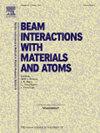Three-dimensional thermal-spike modeling of ion charge-state dependence on sputtering yield in silicon dioxide thin films under MeV heavy-ion irradiation
IF 1.4
3区 物理与天体物理
Q3 INSTRUMENTS & INSTRUMENTATION
Nuclear Instruments & Methods in Physics Research Section B-beam Interactions With Materials and Atoms
Pub Date : 2025-06-19
DOI:10.1016/j.nimb.2025.165780
引用次数: 0
Abstract
The influence of ion charge-state effects on the induced sputtering in silicon dioxide (SiO2) thin films irradiated by 30 MeV Clq+, 40 MeV Auq+ and 50 MeV Cuq+ heavy ions was investigated numerically using the inelastic thermal spike (i-TS) model extended to 3-dimensions. An improved numerical approach using a cylindrical geometry was used to simulate the heat transfer from electronic to lattice subsystems by varying the ion charge-state. The obtained numerical profiles of electronic and atomic temperatures revealed more significant ion charge-state effects close to the center of the formed latent-track and near the surface up to deeper depths of 25 nm. The extracted numerical track-radii revealed small variations (of ∼1.9 to ∼9.9 %) for lower depths up to 25 nm. Then, they reached a mean track-value (around ∼3.9 nm in case of 40 MeV Auq+ ions) corresponding to charge equilibrium, for which, a good agreement was found with the available experimental track-data. The obtained numerical sputtering yields versus penetration depth were finally found to predict better the non-equilibrium to equilibrium sputtering yield ratios, when they were compared to the available experimental data. Adequate mean depths (of ∼10 to ∼15 nm) corresponding to depth at origin of sputtered particles were estimated via i-TS calculation, equivalent to that (of ∼17 nm) previously evaluated from empirical scaling laws of ion mean-charge.
MeV重离子辐照下二氧化硅薄膜中离子电荷态与溅射成品率关系的三维热尖峰模型
采用扩展到三维的非弹性热尖峰(i-TS)模型,研究了离子荷态效应对30 MeV Clq+、40 MeV Auq+和50 MeV Cuq+重离子辐照二氧化硅(SiO2)薄膜诱导溅射的影响。采用改进的圆柱几何数值方法,通过改变离子电荷态来模拟电子子系统到晶格子系统的传热。得到的电子和原子温度的数值分布表明,在形成的潜迹中心附近和表面附近(深度为25 nm),离子荷态效应更为显著。提取的数值轨迹半径在25 nm以下的较低深度显示出很小的变化(约1.9 ~ 9.9%)。然后,他们达到了与电荷平衡相对应的平均轨迹值(在40 MeV Auq+离子的情况下约为~ 3.9 nm),这与现有的实验轨迹数据有很好的一致性。将所得的数值溅射率随侵彻深度的变化规律与现有的实验数据进行比较,发现可以更好地预测非平衡态与平衡态溅射率的比值。通过i-TS计算估计了与溅射粒子原点深度对应的适当平均深度(~ 10 ~ ~ 15 nm),相当于先前根据离子平均电荷的经验标度定律计算的平均深度(~ 17 nm)。
本文章由计算机程序翻译,如有差异,请以英文原文为准。
求助全文
约1分钟内获得全文
求助全文
来源期刊
CiteScore
2.80
自引率
7.70%
发文量
231
审稿时长
1.9 months
期刊介绍:
Section B of Nuclear Instruments and Methods in Physics Research covers all aspects of the interaction of energetic beams with atoms, molecules and aggregate forms of matter. This includes ion beam analysis and ion beam modification of materials as well as basic data of importance for these studies. Topics of general interest include: atomic collisions in solids, particle channelling, all aspects of collision cascades, the modification of materials by energetic beams, ion implantation, irradiation - induced changes in materials, the physics and chemistry of beam interactions and the analysis of materials by all forms of energetic radiation. Modification by ion, laser and electron beams for the study of electronic materials, metals, ceramics, insulators, polymers and other important and new materials systems are included. Related studies, such as the application of ion beam analysis to biological, archaeological and geological samples as well as applications to solve problems in planetary science are also welcome. Energetic beams of interest include atomic and molecular ions, neutrons, positrons and muons, plasmas directed at surfaces, electron and photon beams, including laser treated surfaces and studies of solids by photon radiation from rotating anodes, synchrotrons, etc. In addition, the interaction between various forms of radiation and radiation-induced deposition processes are relevant.

 求助内容:
求助内容: 应助结果提醒方式:
应助结果提醒方式:


